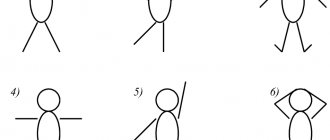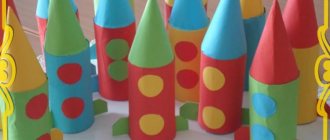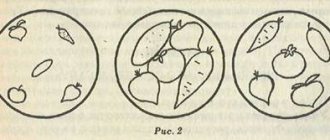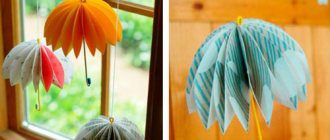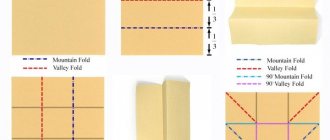Summary of the lesson on designing “Shop” in the middle group
Summary of a design lesson in the middle group) Topic: "Shop» Goal: To teach children to build buildings using a tabletop constructor modeled after the teacher
Tasks:
— continue to introduce children to the sights of our city Makhachkala; expand ideas about the beauty of buildings, their purpose, about the professions involved in the design and construction of residential buildings, hospitals, theaters, shops, schools, kindergartens, etc. - continue to teach children how to design buildings according to the teacher’s model; — continue to teach children to select the necessary parts by size, shape, and combine them; - continue to develop imaginative thinking, speech, visual memory, attention, initiative, sense of beauty; — consolidate knowledge of fire safety rules; — continue to instill moral qualities in children, instill a desire to help heroes in trouble, instill a sense of compassion and responsibility.
Preliminary: work:
- examination of photographs, booklets, books depicting buildings in the city of Makhachkala; - conversation about the sights of the city of Makhachkala - reading works about the native land: "; — games with floor and tabletop construction sets. -D/I “Shop”, D/I “City”, ball games for the classification of objects. Materials and equipment: - boxes with a tabletop designer for each child; -overlapping plates for each child; - envelopes with pictures of goods and signs with the names of stores for each child; - nesting dolls, for each child; — a stand with photographs of buildings of various shops in the city; — a picture depicting a sample store construction.
Progress of the lesson:
Motivation.(Spend before breakfast). Educator: Guys, look who came to us? Children: Matryoshka dolls! V.: That’s right, the Matryoshkas from the village of Matreshkino came to us, let’s say hello! V.: Oh, guys, the Matryoshkas are sad, something must have happened to them... let’s ask.. The children ask why the Matryoshkas are sad. And they told their story: Just recently there was a strong snowstorm in Matreshkino and therefore there was no electricity. At that time we were in the store, making various purchases. And so the Matryoshka sellers lit candles to make it brighter. Several candles fell and a fire started. The nesting dolls all managed to escape, but they could not put out the fire. The store burned down. And there are no more shops in Matreshkino. That's why we came to you guys, in the hope that you will help us.
V.: Yes, guys, a real disaster happened. Can we somehow help the Matryoshkas?
D.: yes, we will help, we will build new stores…. After breakfast, the children prepare their work places and arrange boxes with construction sets. (The tables are arranged in the letter P, in the middle there is a bench with boxes and attributes for the lesson). Children sit on chairs.
The teacher draws the children's attention to the photographs. — Guys, what is the name of the city in which we live? Look at the buildings here in the photographs? (Children's answers) - Tell me, please, who comes up with the idea of building such buildings? (If the children find it difficult, give them a hint) - If you build a house without a good plan, you won't end up with grief and worries. So that there would be less grief and worries in construction, there is such a respected profession in the world - architect. A good architect first builds in his mind the house you want. Then he draws his ideas on the drawings so that the builders understand what to do. A good house should be durable, warm, beautiful, comfortable, and bright. It should look beautiful among neighboring houses and not spoil the landscape with its appearance. The work of an architect has something of an artist and something of an engineer. This is a very interesting but difficult profession. — Why do we need different buildings in the city, besides residential buildings?
D.: Schools and kindergartens so that children receive knowledge, in hospitals doctors take care of our health, shops to buy food, clothes, shoes...
V.: What are we planning to do?
D.: Build stores using nesting dolls.
Q: What misfortune happened in Matreshkino? D.: Fire!
Q: Could the fire have been avoided? Let's give the Matryoshkas some fire safety tips.
Then the teacher invites the children to the tables to build shops. The teacher makes a demonstration. They remember the names of the construction parts needed for construction (bricks, large, medium prisms, long bars). They repeat the sequence, the structure must be strong, lay all the parts evenly, pressing tightly against each other, decorate the building with benches and trees. When the buildings are ready, the teacher offers the children goods for the shops. They are in envelopes, and there are signs for stores. Since children cannot read, the purpose of the store will be determined by the contents of the “product” in the envelopes. Afterwards, the children invite the Matryoshkas to visit their stores and tell them what products are on sale. They are playing with the building. The nesting dolls are happy and say thank you to the children.
Abstract of GCD for design in the middle group “Steam locomotive with carriage”
Abstract of GCD for design: “DESIGN ACCORDING TO THE “SIDE VIEW” SCHEME OF A STEAM LOGO WITH A CARRIAGE” (middle group)
Target
: to improve children’s design skills using a ready-made construction scheme.
Educational objectives:
— Strengthen the ability to analyze ready-made graphic models of the design of objects (locomotive and carriage).
— To consolidate the skill of implementing a design diagram (a locomotive with a carriage) in construction. Developmental tasks
: - Clarify children's knowledge about the train as a form of transport.
— Expand your horizons. Educational objectives
: - To consolidate the skill of coordinating the actions of children with each other in joint work, to develop cooperation skills.
Materials and equipment
: — demonstration diagrams of a locomotive and a carriage (side view), similar distribution diagrams; - handout building material corresponding to the proposed diagrams (plus similar demonstration material for analyzing the diagrams of a steam locomotive and carriage): * for a steam locomotive - a long brick, 2 bricks smaller than average, 4 thick bars, 2 small bricks, 2 small triangular prisms, a cylinder; * for a carriage – 2 long bricks, 4 cubes, 2 small triangular prisms, 2 medium bricks, 2 small half-cubes; — animated video “Locomotive Bukashka”; — multimedia presentation-accompaniment; - magnetic board; - laptop; - projection screen.
1. Organizational stage
Pedagogical goal
: to create playful motivation for constructive activities, to evoke an emotional response in children, to develop imagination and cognitive activity.
Children's goal :
remember familiar types of transport, strengthen the ability to solve riddles.
Methods and techniques :
guessing riddles, conversation.
— Guys, do you like to travel? (Yes) - How can you go on a trip? (By car, by bus, by plane, etc.) - And I suggest you go to visit the animals on... Try to guess this type of transport yourself: A Centipede rushes along steel paths. Knock-knock-knock, round heel clicks. With a cheerful song along the iron ladder. (Train) - Our train will be built from building material.
2. Stage based on children’s personal experience
Pedagogical goal :
to clarify children’s knowledge about the train as a form of transport, to enhance children’s personal experience, to broaden their horizons.
Children's goal :
remember everything they know about the train.
Methods and techniques :
problematic questions, demonstration of a multimedia presentation, teacher's story, indirect hint, leading questions, praise.
— Guys, how many of you have traveled by train, please raise your hands? There are so many travelers in our group! Let's check what you know about this type of transport! *Children sit in front of the projection screen. — What type of transport is the train: land, water or air? (A train is a ground transport) - slide number 2. - Remember what parts the train consists of? (From a steam locomotive and carriages) - slide number 3. - Why does a train need a steam locomotive? (It pulls cars behind it because it has an engine) - slide number 4. - What types of trains are there? (Passenger trains transport people, and freight trains carry different types of cargo) - slides No. 5-7. * Did you know that the fastest (super-fast) train in the world carries passengers in Japan. This is a magnetic levitation train; it does not touch the rails, but “floats” above them. Such a super-high-speed train is 5-6 times faster than a regular train (slide No. 8). And in the near future, Russian double-decker trains will carry participants and guests of the Winter Olympics to Sochi (slide No. 9) - Without what can the train not go on a trip? (He needs rails - a railroad). —Who controls the train? (Driver) - slide number 10. Well done, you know a lot about trains!
3. Main stage
Pedagogical goal :
to consolidate in children the ability to analyze ready-made graphic models of the design of objects (locomotive and carriage);
consolidate the skill of implementing a design diagram (a locomotive with a carriage) in a building; to develop the skill of coordinating children’s actions with each other (cooperation). Children's goal :
to figure out what parts will be needed to build a steam locomotive and a carriage;
build a steam locomotive with a carriage together with a friend. Methods and techniques :
analysis of building diagrams, correlation of diagrams with the existing set of building parts, conversation, indirect hints, praise, independent construction according to the diagram. — To build our own train, we will need drawings of a steam locomotive and a carriage depicting the necessary construction parts. *Schemes are posted on a magnetic board. - Let's look at them carefully (from bottom to top). Let's start with the locomotive.
*A sequential analysis of the locomotive diagram (side view) is being carried out. Children can match the parts proposed for building a steam locomotive with the diagram.
— What construction parts will we use to make the wheels? (From triangular prisms) - What building part will be needed for the base of the locomotive? (Long brick) - Our locomotive has 2 main parts - front and rear. What's in the front? (Engine, pipe) And in the back? (Driver's Cabin) - List the construction parts for the front of the locomotive. (Whetstones, small brick). Specify where the small brick will be located? (Ahead) - What parts will be needed for the walls of the driver's cab? (The bricks are smaller than average) And for the door? (Bar) What will we make the roof of the cabin from? (From small bricks) - What will we make the locomotive pipe out of? (From the cylinder)
*During the conversation, the teacher uses indirect hints, leading questions, and praise. — Now let’s look at the drawing of the carriage (also from bottom to top).
Are the wheels of a carriage and a steam locomotive similar? (Yes) So they will be made from the same building parts. Name them (triangular prisms). — Is the base of the carriage the same as that of a steam locomotive? (Yes) Which construction part will we take? (Long brick) - What building parts will be needed to build the walls of the carriage? (Cubes, medium bricks). — What construction parts will be needed for window partitions? (Half cubes). — What will we make the roof of the carriage from? (Made from a long brick). — We found out what parts our train will be built from. Let's take a little rest. *Physical training: Up and down hand jerks, as if we were waving flags. Let's stretch our shoulders. Hands move towards. (One hand up, the other down, change hands with jerks.) Hands on your sides. Smile. Lean left and right. (Bend to the sides.) Start squats. Don't rush, don't lag behind. (Squats.) And at the end - walking in place. Everyone has known this for a long time. (Walk in place.)
- Now I suggest you build your own train for our journey to the animals! You will build in pairs. Agree which of you will build a locomotive and which will build a carriage, and take a suitable box of building material and a drawing.
*During independent work, the skill of coordinating children’s actions with each other (cooperation) is consolidated. Upon completion of construction, children combine the locomotive with the carriage into a train.
4. Consolidating children's knowledge
Pedagogical goal:
consolidate the skill of correlating a building with a design diagram (locomotive and carriage).
Children's goal :
help a friend build a train.
Methods and techniques :
correlation of the finished building with the diagram, praise, encouragement. The teacher invites the children to check their partner’s construction and, if necessary, make adjustments to it in accordance with the drawings.
*Tick the children who worked together and helped each other.
5. Final stage
Pedagogical goal :
reflection;
motivation for further knowledge of modes of transport. The goal is for children :
to think whether everything that was planned was successful.
Methods and techniques :
watching a video, conversation, gift for children.
Children go by train to visit the animals (slide No. 11). There is an image of animals on the projection screen (slide No. 12). — Hello, guys, how did you come to us? (on the train) - Really, you built it yourself? Well done! Was it easy for you to build the train? What was the hardest thing? Did you help each other? Did everything work out for you? — Want to know more about trains and other modes of transport? (Yes) This book will help you with this (Encyclopedia “Transport”). — Now let’s all take a train ride together (watch the animated video “Bukashka the Steam Locomotive”) - slide number 13.
